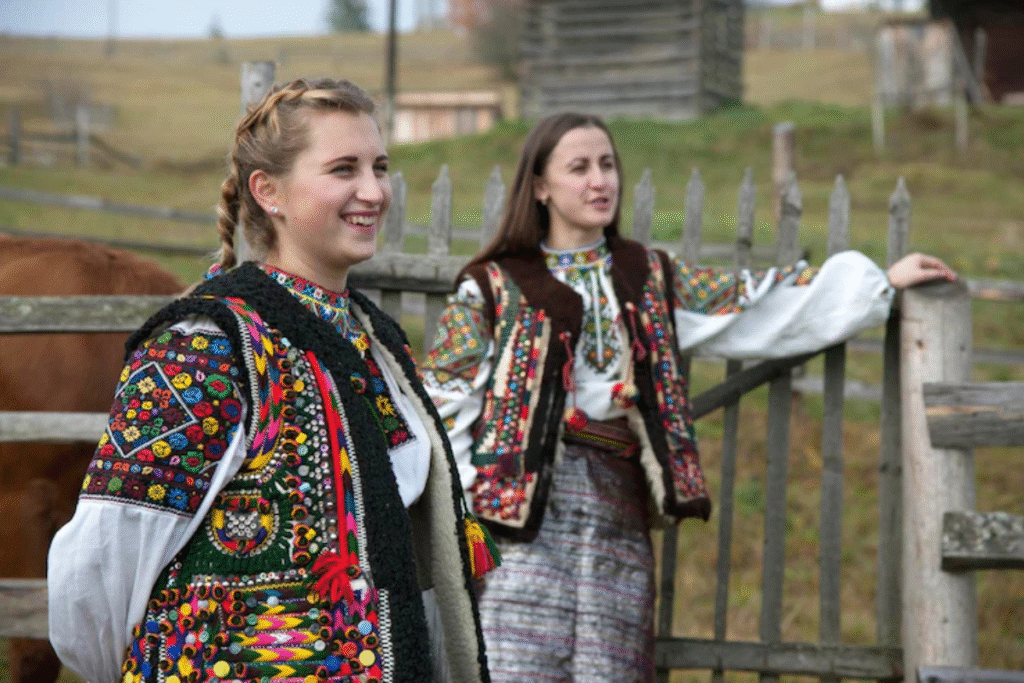Overview to Traditional Romanian Clothing
Traditional Romanian clothing, known locally as “costum popular”, is a deeply rooted aspect of Romania’s cultural and ethnic identity. Each region of the country—whether it’s Transylvania, Maramureș, Moldavia, or Wallachia—boasts its own distinct designs, patterns, and symbols that reflect the area’s history and customs.
These clothes are still proudly worn today during national holidays like June 24th – Universal Day of the Romanian Blouse (Ziua Iei), religious events, and folkloric festivals.
Historical Background of Romanian Traditional Clothes
Origins and Influences
Romanian traditional clothing has evolved over centuries, blending Dacian, Roman, Slavic, and Ottoman influences. The earliest depictions date back to ancient Dacia, where woolen tunics and embroidered garments were common. Over time, local craftsmanship developed into a refined art form that used nature-inspired motifs and hand-woven fabrics.
From Utility to Art
Initially practical and suited to Romania’s diverse climate, these garments were later adorned with embroidery, beads, and lace, especially in more ceremonial or festive versions. Clothing became a form of storytelling, passed through generations as a visual legacy.
Key Components of Traditional Clothes in Romania
Traditional Romanian clothing is distinct for men and women, with each gender’s attire composed of several symbolic elements.
Women’s Traditional Clothing
- Ia (Blouse): A white cotton or linen blouse with intricate hand embroidery, often on the sleeves and chest. Patterns vary by region.
- Fota or Catrință: A wrap-around skirt worn over a white underskirt, decorated with horizontal or vertical stripes and often metallic threads.
- Opinci: Traditional leather shoes tied with laces that wrap around the ankle and calf.
- Head Coverings: Married women often wear scarves or headdresses, while unmarried women may wear floral crowns.
Men’s Traditional Clothing
- Shirt (Cămașă): Similar in fabric to the ia, often longer and worn with a belt.
- Ițari: Tight woolen trousers, often white, tucked into boots.
- Coat (Cojoc): A decorative sheepskin coat worn during winter.
- Hat: Felt or straw hats are common, with different shapes and decorations depending on the region.
Regional Variations and Their Unique Styles
Romania’s geography—ranging from mountains to plains—has led to rich regional diversity in traditional clothing. Here are some prominent examples:
Transylvania
- Strong Hungarian and Saxon influences.
- Rich embroidery using bold colors like red and black.
- Multi-layered skirts and heavily beaded aprons.
Maramureș
- Very conservative and rustic style.
- Use of natural dyes and wool.
- Wooden belts (cingători) and distinctive headwear.
Moldavia
- Delicate and complex needlework in cross-stitch.
- Motifs often represent natural elements like trees, birds, and the sun.
- White and red are dominant colors.
Oltenia and Wallachia
- Lavish decoration with metallic threads and sequins.
- Multiple layers and more luxurious fabrics.
- Distinctive geometrical patterns.
Symbolism in Patterns and Colors
Each element of traditional Romanian clothing has a deeper meaning:
- Red: Represents life, passion, and protection against evil.
- Black: Often used in mourning but also symbolizes strength and stability.
- White: Purity, divinity, and connection to nature.
- Motifs: Spirals, crosses, and stars reflect spirituality, continuity, and connection to the cosmos.
Patterns aren’t just artistic choices—they often indicate marital status, age, or social rank. For example, a young unmarried woman might wear brighter colors and floral motifs, while older women opt for more subdued tones and geometric designs.
Traditional Clothes in Modern Romania
Despite the modernization of fashion, traditional clothes in Romania have not disappeared—they’ve evolved.
Cultural Revivals and Fashion
Romanian designers like Ie Clothing, Andra Clitan, and Adrian Oianu have modernized the ia, blending tradition with contemporary fashion. Celebrities, influencers, and even royals have been seen wearing Romanian blouses, giving traditional clothing a global stage.
National Celebrations
Traditional clothing is proudly worn on National Day (December 1st) and at major religious festivals. Schools often host cultural days where children wear regional outfits and learn about their heritage.
Tourism and Ethnography
Museums such as The National Museum of the Romanian Peasant (Muzeul Țăranului Român) in Bucharest and the ASTRA Museum in Sibiu showcase vast collections of traditional garments. These have become must-see attractions for visitors looking to understand Romanian culture.
Where to See and Buy Traditional Romanian Clothing
Where to See
- ASTRA Museum, Sibiu
- Village Museum, Bucharest
- Ethnographic Museums in Cluj-Napoca, Iași, and Brașov
These places display authentic costumes and often host craft fairs and folk demonstrations.
Where to Buy
- Online Shops: e.g., Etsy, RomanianBlouse.com
- Local Markets and Artisan Fairs
- Craft Villages: Ieud, Breb, and Horezu are known for skilled artisans.
When buying, look for handmade embroidery and natural fibers to ensure authenticity.
FAQs About Traditional Clothes in Romania
Q1.What is the Romanian traditional blouse called?
It’s called an ia—a white blouse traditionally handmade and embroidered with regional patterns. It’s an iconic garment of Romanian women’s attire.
Q2.Are traditional Romanian clothes still worn today?
Yes, especially during holidays, weddings, and cultural events. Many people also wear modern adaptations of traditional styles.
Q3.Do different regions have different styles?
Absolutely. Romania’s diverse geography and cultural influences have led to unique styles in each region, such as Transylvania, Maramureș, and Moldavia.
Q4.Can I wear traditional Romanian clothing as a tourist?
Yes! Wearing a ia or other garments respectfully appreciated, especially during festivals or while visiting historical sites.
Q5.How can I tell if a Romanian blouse is authentic?
Look for hand-stitched embroidery, natural fabrics like cotton or linen, and traditional patterns specific to a Romanian region.
Conclusion
Traditional clothes in Romania offer a stunning window into the country’s soul—colorful, intricate, and deeply symbolic. From the rural villages of Maramureș to the modern runways of Bucharest, these garments continue to inspire pride and creativity.
Whether you’re a cultural enthusiast, fashion lover, or curious traveler, exploring Romanian traditional clothing is a rich and rewarding experience. It’s not just about clothing—it’s about history, identity, and keeping a nation’s soul alive through stitches and stories.



